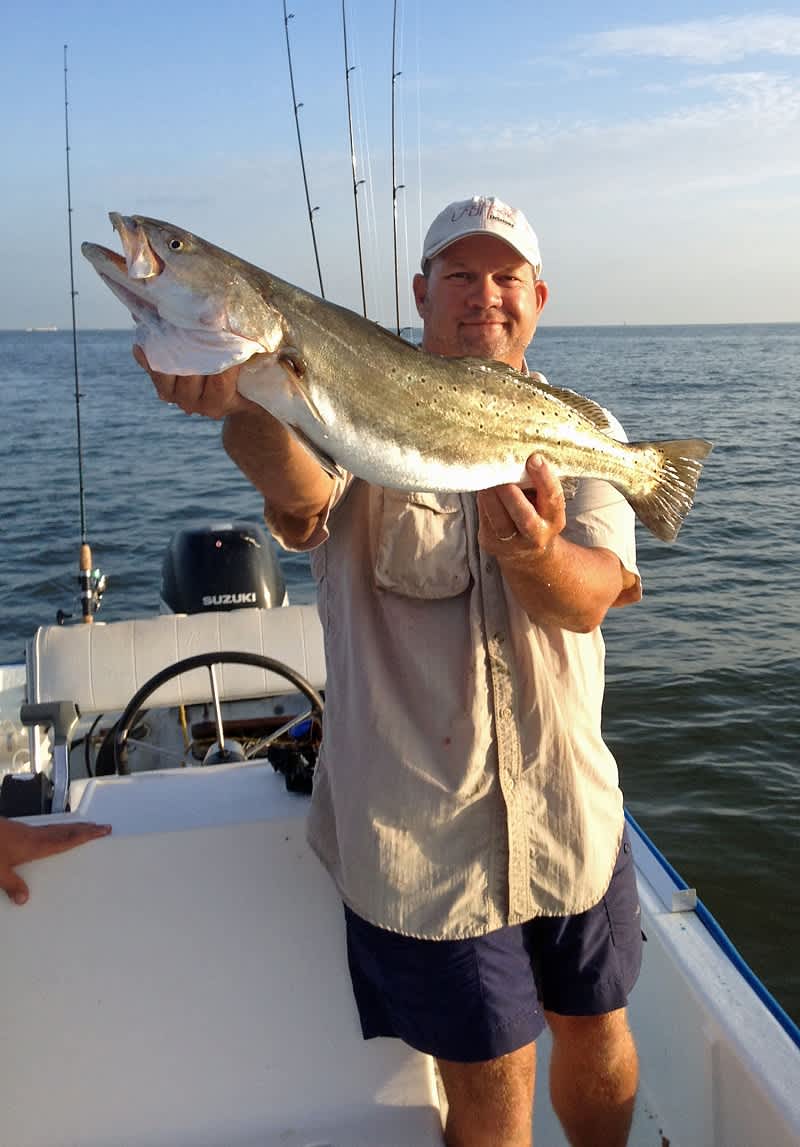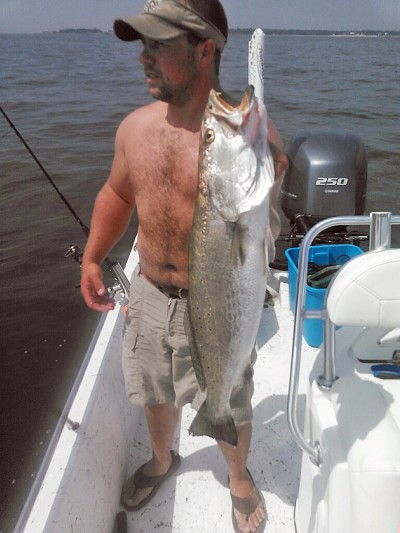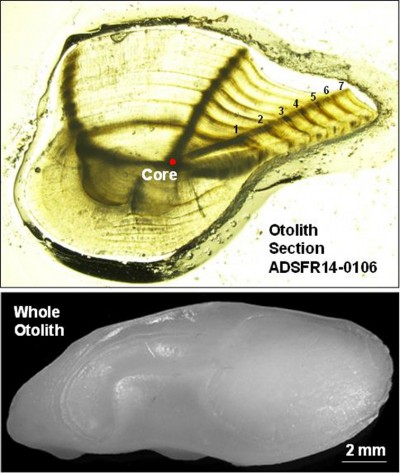Fishing for Alabama Gator Trout
David Rainer 09.16.14

One gator has dominated the outdoors coverage this summer and rightfully so. Mandy Stokes’ world record American alligator at 15 feet, nine inches is famous worldwide.
However, a gator of another sort has surfaced along the Alabama Gulf Coast that has inshore fishermen excited. It’s called a gator trout. Conjecture is that when the speckled trout (spotted seatrout for you purists) reaches 25 inches or larger, its tooth-filled mouth begins to resemble that toothy, giant reptile.
Highlighted by the Alabama Deep Sea Fishing Rodeo record trout of 8.88 pounds caught by Trenny Woodham in Theodore Industrial Canal, 2014 has been a banner year for gator trout.
Chris Blankenship, Director of the Alabama Marine Resources Division, said there is no research to pinpoint why some years are better for monster trout.
“The big fish we’re catching now are eight or nine years old,” Blankenship said. “Sometimes we have these spells where we catch a lot of big fish. That trout brought in at the rodeo was impressive.”
Inshore guide Jay Gunn, who spends most of his time in the Fort Morgan area, said there’s usually no warning that a gator trout is on the prowl until it takes the bait.
Based on his anecdotal evidence, Gunn thinks the 2010 oil spill may have impacted the trout fishery by reducing the harvest of specks for most of the spawning season.
“My theory is that most of those trout didn’t get caught and were able to spawn,” Gunn said. “That helped with recruitment the next year. That meant there were a lot of three-pound trout in the fishery. When they get that big, they start splitting away from the group and don’t run with the school anymore.
“Because those fish didn’t get caught, instead of seeing a lot of fish between five and seven pounds, we’re seeing a number of fish between eight and nine pounds. There are some not weighed and turned loose that could be even bigger.”
Gunn’s largest trout of 2014 measured 30-1/2 inches, which he estimated at nine-plus pounds. Like most big fish he’s caught during his career, he had no idea the fish was in the area.
“You kind of catch them out of nowhere,” he said. “All of sudden it happens. You don’t get many of those bites. It almost never happens when you’re catching other fish.”
When it comes to gator trout, it’s hard to beat live bait, according to Gunn, although he did catch a 29-incher on a DOA shrimp earlier this year.

“I’ll probably catch 50 trophy trout on croakers or menhaden for every one I catch on artificial,” he said. “I always use a Kahle hook with live bait, and almost every time the fish will be hooked in the corner of the mouth. If you hook one on a lure, your chance of landing that fish goes down with the size of the bait. If you’re fishing with a MirrOlure or Zara Spook, that trout is going to make a long run and then come to the top and shake his head. Then he’s going to make a shorter run and come to the top and shake his head. The weight of the lure can make it easier for the trout to throw the bait.
“The fish I catch on croakers seldom jump at all. They usually run and run and run.”
Inshore guide Bobby Abruscato, who has been on the winning team in three straight redfish tournaments, said the biggest trout he has seen all year was boated by his friend Bruce Howle, Jr., who caught a 30-incher that Abruscato estimated at 10 pounds. Howell released the fish after photos were taken.
Abruscato said he seconds Gunn’s assessment that the oil spill likely kept a good many large trout from being thrown into anglers’ ice chests.
“I certainly think the oil spill was one of the factors,” Abruscato said. “The two summers after that were some of the best years I’ve had for trout. It’s still good, but not as good as that. I think what happened is with those fish in the population, it allowed some of those fish to grow and get to be that trophy size.
“When you start talking about catching a seven-plus fish, you’re just going to have to be real lucky. There are some guys who cut down on the luck, but with the super-big trout we’re seeing this year, it’s just luck. You have to be in the right place and have something on the end of the line that they want to eat.”
Abruscato says larger trout tend to be in or near deeper water, like the mouth of Dog River, Theodore Industrial and Mobile River, especially during the fall and winter.
“I just think those bigger fish like to stay in those areas where the salinity is more stable,” he said. “But that doesn’t mean they won’t move up in the shallows to feed. The biggest fish I ever caught in my life was in a foot of water. I was wade-fishing in May. The fish was 30 inches and hit a Catch 2000 MirrOlure. That fish knocked some mullet almost up on the beach. I threw over there and he nailed it.”
Both Abruscato and Gunn think the fall fishing in the Mobile Delta and other estuaries could be excellent this year, barring some sort of tropical weather.
“We haven’t had much rain lately,” Abruscato said. “With the salinity, the fish have pushed up the bay.”
Gunn added, “I think there are a good number of fish 15 to 17 inches, and they should be easy to catch. As little rain as we’ve had, they should be moving into the upper ends of the bays. It should be a good year in the Delta if we don’t get a storm to wash the shrimp out.”

But back to Woodham’s rodeo record trout. Will Patterson of Dauphin Island Sea Lab has headed a project to collect otoliths (ear bones) from speckled trout during the rodeo for the past two years. Like tree rings, the otolith reveals the age of the trout. The rodeo-record trout was a seven-year-old female.
Patterson said there is not enough evidence to conclude the oil spill had an effect on the number of gator trout seen in 2014. He said there could be several factors involved.
“A lot of fish in that genus are cannibalistic, so the bigger fish eat the smaller fish,” Patterson said. “When I was in college and working at a marina in Virginia, there’s a cousin to the speckled trout called the weakfish. I was cleaning a 14-pound weakfish and pulled a four-pound weakfish out of its stomach.”
Patterson said the otolith study will allow marine scientists to gather significantly more information on speckled trout.
“An increase in size and age will be recorded in the otoliths,” he said. “We’ve got two years of data now, and we’re going to keep this going. There is a wealth of information to be gathered in rodeo samples.”
Blankenship said the proof of the great fishing off Alabama is in the number of state records broken in the last few years. He said 39 saltwater records have been broken since 2011.
“It’s encouraging to see all these big fish,” Blankenship said. “Our inshore artificial reef program and other habitat protections we’ve done have helped. We closed some areas in north Mobile Bay to shrimping, and Grand Bay is closed to trawling. I think things like that really give those smaller fish sanctuary and help with the shrimp production. That allows those fish to have plenty to eat and facilitates great growth.
“I get excited about seeing big fish. I get to see the applications for state-record fish before they go out to the committee. I’m proud when I see the size of the fish being caught off Alabama. This is just more confirmation of what a great fishery we have.”

